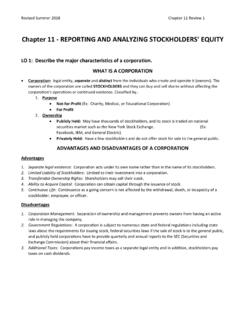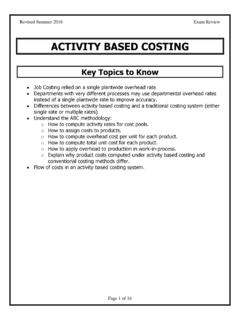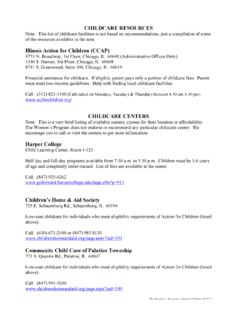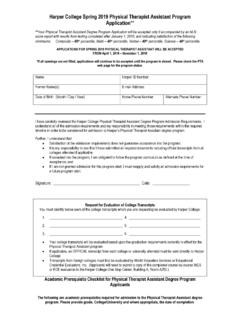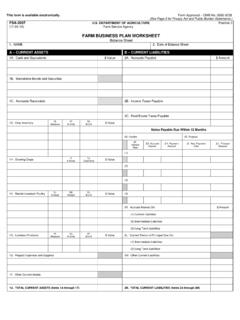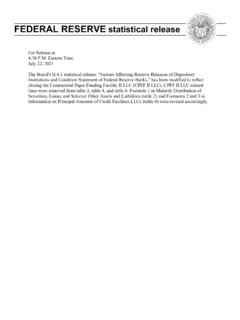Transcription of Chapter 12 - STATEMENT OF CASHFLOWS
1 Revised Summer 2018 Chapter 12 Review 1 Chapter 12 - STATEMENT OF CASHFLOWS LO 1: Discuss the usefulness and format of the STATEMENT of cash flows. USEFULNESS OF THE STATEMENT OF CASH FLOWS STATEMENT of Cash Flows: reports the cash receipts and cash payments from operating, investing, and financing activities during a period. Provides information to help assess: 1. Entity s ability to generate future cash flows. 2. Entity s ability to pay dividends and meet obligations. 3. Reasons for difference between net income and net cash provided (used) by operating activities.
2 4. Cash investing and financing transactions during the period. CLASSIFICATION OF CASH FLOWS OIF I can pass Operating, Investing, and Financing 1. Operating Activities: the cash effects of transactions that create revenues and expenses. (Income STATEMENT Items) Cash inflows: From sale of goods or services. From interest received and dividends received. Cash outflows: To suppliers for inventory. To employees for wages. To government for taxes. To lenders for interest. To others for expenses. Revised Summer 2018 Chapter 12 Review 2 2.
3 Investing Activities: cash transactions that a. The purchase or disposal of investments and property, plant, and equipment. b. Lending money and collecting the loans. (Long-Term Assets) Cash inflows: From sale of property, plant, and equipment. From sale of investments in debt or equity securities of other entities. From collection of principal on loans to other entities. Cash outflows: To purchase property, plant, and equipment. To purchase investments in debt or equity securities of other entities.
4 To make loans to other entities. 3. Financing Activities: a. Obtaining cash from issuing debt and repaying the amounts borrowed. b. Obtaining cash from stockholders, repurchasing shares, and paying dividends. (Long-Term Liabilities and Stockholders Equity) Cash inflows: From sale of common stock. From issuance of debt (bonds and notes). Cash outflows: To stockholders as dividends. To redeem long-term debt or reacquire capital stock (treasury stock).
5 Revised Summer 2018 Chapter 12 Review 3 SIGNIFICANT NONCASH ACTIVITIES Companies report noncash activities in either a 1. Separate schedule (bottom of the STATEMENT ). 2. Separate note to the financial statements. Examples include: Direct issuance of common stock to purchase assets. Conversion of bonds into common stock. Issuance of debt to purchase assets. Exchanges of plant assets. FORMAT OF THE STATEMENT OF CASH FLOWS Revised Summer 2018 Chapter 12 Review 4 LO 2: Prepare a STATEMENT of cash flows using the indirect method.
6 STATEMENT of cash flows is prepared differently from the three other basic financial statements. Three sources of information: 1. Comparative balance sheets: indicates the amount of changes in asset , liability, and stockholders; equity accounts from the beginning to the end of the period. 2. Current income STATEMENT : helps determine the amount of net cash provided or used by operating activities during the period. 3. Additional information: Such information includes transaction data that are needed to determine how much cash was provided or used during the period.
7 THREE MAJOR STEPS TO PREPARE THE STATEMENT OF CASH FLOWS Step 1: Determine net cash provided/used by operating activities by converting net income from an accrual basis to a cash basis. Step 2: Analyze changes in noncurrent asset and liability accounts and record as investing and financing activities, or disclose as noncash transactions. Step 3: Compare the net change in cash on the STATEMENT of cash flows with the change in the cash account reported on the balance sheet to make sure the amounts agree. STEP 1: OPERATING ACTIVITIES TWO METHODS: DIRECT AND INDIRECT.
8 THESE NOTES FOCUS ON INDIRECT. Companies favor the INDIRECT METHOD for two reasons: 1. Easier and less costly to prepare. 2. Focuses on differences between net income and net cash flow from operating activities. Both methods result in the SAME AMOUNT of cash flow from operating activities. They differ in the way they report cash flows from operating activities. Revised Summer 2018 Chapter 12 Review 5 INDIRECT METHOD *Goal is determine net cash provided/used by operating activities by converting net income from accrual basis to cash basis.
9 Steps for the Indirect Method 1. Start with NET INCOME (going to convert accrual net income into cash from operations) 2. ADD (+) noncash expenses such as depreciation, amortization, and depletion. 3. ADD (+ ) losses on sale of long-term assets. 4. DEDUCT (-) gains on sale of long-term assets. 5. Analyze changes to noncash CURRENT asset and CURRENT LIABILITY ACCOUNTS. A. DEDUCT increases in current asset account. B. ADD decrease in current asset account. Current Assets INCREASE , then you are going to DECREASE Net Income.
10 Current Assets DECREASE , then you are going to INCREASE Net Income. Example: C. ADD increases in current liability account. D. DEDUCT decrease in current liability account. Example: Current Liabilities INCREASE , then you are going to INCREASE Net Income. Current Liabilities DECREASE , then you are going to DECREASE Net Income. Ex) YR 2 YR 1 Accounts Payable $7,000 $5,000 *ACCOUNTS PAYABLE INCREASED BY $2,000 FROM YR 1 TO YR 2 SO WE ARE GOING TO INCREASE NET INCOME BY $2,000 TO GET CASH FROM OPERATIONS.
